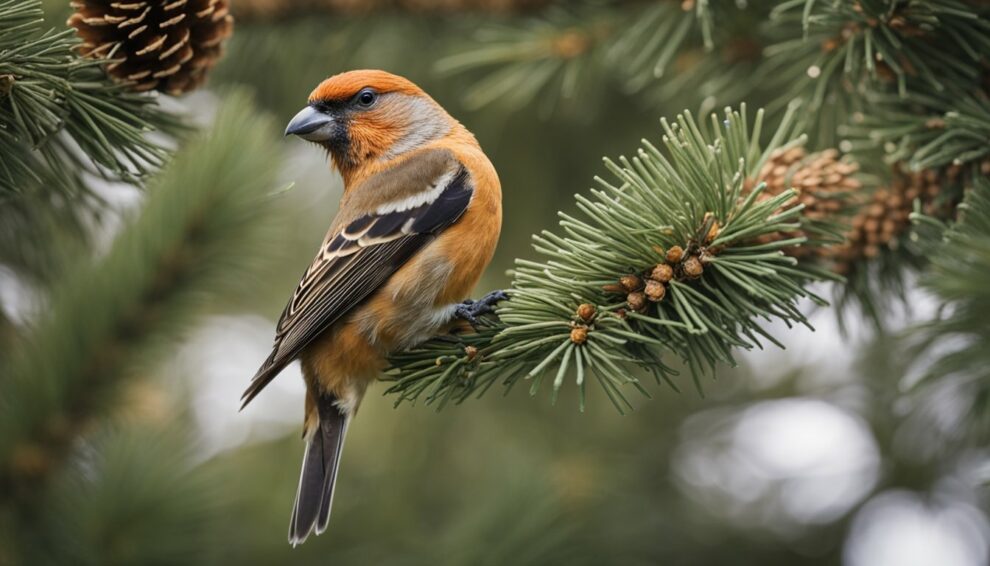The Crossbill is an interesting bird species with a unique adaptation that sets it apart from other birds.
Known for its twisted beak phenomenon, the Crossbill has adapted to its environment by developing a beak that is specially designed to extract seeds from pine cones.

The Crossbill’s beak is a remarkable feat of evolution, allowing the bird to access food sources that other species cannot.
The beak is crossed, which enables the bird to pry open the scales of a pine cone and extract the seeds inside.
This adaptation has allowed the Crossbill to thrive in environments where other birds struggle to survive.
The Crossbill’s eating habits are not only unique but also efficient.
The bird can consume up to 3,000 conifer seeds in a day, thanks to its specialized beak.
This adaptation has enabled the Crossbill to become a master of survival, thriving in environments where other birds would struggle to find enough food.
The Crossbill’s Unique Bill
The Crossbill is a fascinating bird with a unique bill that has evolved to help it extract seeds from conifer cones.
Let’s take a closer look at the anatomy of the Crossbill’s beak and how it has adapted to its feeding technique.
Anatomy of the Crossbill’s Beak
The Crossbill’s bill is a specialized tool that has evolved to help it access the nutritious seeds inside conifer cones.
The bill is crossed, with the upper and lower mandibles curving in opposite directions.
This unusual shape allows the Crossbill to insert its bill into a cone and pry it open, exposing the seeds inside.
Beak Adaptation and Seed Extraction
The Crossbill’s beak is adapted to the shape of the conifer cone, allowing it to extract seeds that other birds cannot reach.
The Crossbill’s mandibles are strong and flexible, allowing it to apply pressure to the cone and twist its bill to extract the seeds.
This unique adaptation allows the Crossbill to feed on the seeds of a wide variety of conifer species, including pine, spruce, and fir.
The Crossbill’s feeding technique is highly specialized and efficient.
It can extract up to 3,000 seeds per day, making it an important seed disperser for conifer forests.
As the Crossbill feeds, it also helps to shape the forest ecosystem by selecting the strongest and healthiest trees to feed on.
In conclusion, the Crossbill’s unique bill is a fascinating example of evolution at work.
Its specialized shape and feeding technique have allowed it to thrive in conifer forests and play an important role in the ecosystem.
Next time you see a Crossbill in action, take a moment to appreciate the wonder of nature’s twisted beak phenomenon.
Habitat and Distribution

Crossbill Habitats Across Continents
Crossbills are fascinating birds with unique physical adaptations that allow them to extract seeds from conifer cones.
These birds are found across the Northern Hemisphere, from North America to Europe and Asia.
They inhabit coniferous forests and woodlands, where they feed on the seeds of pine, spruce, hemlock, Douglas-fir, and larch trees.
In North America, the Red Crossbill is the most widespread species, found from Alaska to Mexico.
In Europe, the Common Crossbill is the most common species, found from Scandinavia to the Mediterranean.
In Asia, there are several species of crossbills, including the Parrot Crossbill, the Two-barred Crossbill, and the White-winged Crossbill.
Migration Patterns and Nomadic Lifestyle
Crossbills are nomadic birds that move in search of food.
They are known for their unpredictable migration patterns, which can take them far beyond their usual range.
When food is scarce in one area, crossbills will move to another area with more abundant food sources.
Some crossbills are also known for their irruptive behavior, which occurs when large numbers of birds move into an area where they are not usually found.
This can happen when there is a sudden abundance of food in an area, such as after a large cone crop.
In North America, crossbills are known to move north in the summer and south in the winter.
This pattern is reversed in Europe, where crossbills move south in the winter and north in the summer.
These movements are driven by changes in food availability and weather patterns.
Overall, crossbills are fascinating birds with unique adaptations and unpredictable behavior.
Their nomadic lifestyle and ability to extract seeds from conifer cones make them important members of the forest ecosystem.
Breeding and Social Behavior

Crossbills are fascinating birds with unique eating habits that are a result of their twisted beak phenomenon.
But their breeding and social behavior is equally intriguing.
Mating Rituals and Nest Building
Crossbills are monogamous birds, meaning they mate for life.
During the breeding season, which typically occurs between March and July, males will use their distinctive calls and songs to attract females.
Once a pair has formed, they will work together to build their nest, which is typically a cup-shaped structure made of twigs, grass, and other materials found in their environment.
The female crossbill will lay between two to five eggs in the nest, which she will incubate for around two weeks.
Once the eggs hatch, both parents will work together to feed and care for their young.
The Social Life of Crossbills
Crossbills are social birds that typically live in flocks. These flocks can range in size from just a few birds to several hundred.
Within these flocks, crossbills will often form smaller groups based on age and sex.
Male crossbills tend to be more aggressive than females, and will often defend their territory and mate fiercely.
However, they also play an important role in raising their young, and will help with feeding and caring for their offspring.
Overall, crossbills are fascinating creatures with unique breeding and social behavior.
Their monogamous mating habits and cup-shaped nests are just a few examples of the interesting behaviors that make them stand out in the bird world.
Conservation and Future of Crossbills

Threats to Crossbill Populations
Crossbills are facing several threats to their population, including habitat loss and fragmentation.
The destruction of coniferous forests, which are their primary habitat, has led to a decline in their numbers.
The loss of these forests is due to human activities such as logging, mining, and urbanization.
Another threat to crossbills is competition for food with other bird species.
The red squirrel is also a major competitor for the seeds of coniferous trees, which are the primary food source for crossbills.
As a result, crossbills are often forced to move to new areas in search of food, which can be difficult for them.
Conservation Efforts and Public Awareness
Conservation efforts are underway to protect crossbills and their habitats.
The first step is to raise public awareness about the importance of these birds and their unique eating habits.
This can be done through educational programs and campaigns that highlight the role of crossbills in the ecosystem.
Another important step is to protect and restore their habitats.
This involves preserving and restoring coniferous forests and reducing human activities that lead to habitat loss and fragmentation.
Conservation efforts also involve monitoring crossbill populations and studying their behavior and eating habits.
This information can help scientists better understand these birds and develop strategies to protect them.
In conclusion, crossbills are fascinating creatures with unique eating habits that make them an important part of the ecosystem.
However, they are facing several threats to their population, including habitat loss and competition for food.
Conservation efforts are underway to protect these birds and their habitats, and public awareness is key to their success.
Frequently Asked Questions

How has the crossbill’s unique beak shape evolved to aid its feeding habits?
The crossbill’s beak is uniquely shaped to help it extract seeds from pine cones.
The beak is twisted, with the tips of the upper and lower mandibles crossing over each other.
This allows the crossbill to pry open the scales of a pine cone and extract the seeds inside.
The beak is so specialized that it can even extract seeds from cones that are still closed.
In what ways do crossbills use their twisted beaks to obtain food?
Crossbills use their beaks to extract seeds from the cones of coniferous trees.
They hold the cone in their feet and use their beaks to pry open the scales of the cone to access the seeds inside.
The crossbill’s beak is so specialized that it can extract seeds from cones that are still closed.
Can you describe the types of environments where crossbills are most likely to thrive?
Crossbills are found in coniferous forests throughout North America, Europe, and Asia.
They are most commonly found in areas with abundant pine, spruce, and fir trees.
Crossbills are nomadic and move around in search of food, so their range can vary depending on the availability of food.
What are the differences between the beaks of crossbills and other birds like seagulls or flamingos?
The beak of a crossbill is unique among birds. It is twisted, with the tips of the upper and lower mandibles crossing over each other.
This allows the crossbill to pry open the scales of a pine cone and extract the seeds inside.
In contrast, the beaks of seagulls and flamingos are not twisted and are adapted for catching fish and filtering small organisms from the water, respectively.
How does the crossbill’s beak shape affect its diet and nutrition?
The crossbill’s beak shape is perfectly adapted for extracting seeds from pine cones.
This allows the crossbill to access a food source that is not available to other birds.
Pine seeds are high in fat and protein, which provides the crossbill with the nutrition it needs to survive.
What role does the crossbill play in its ecosystem, and how does its beak contribute to this?
Crossbills play an important role in their ecosystem by helping to disperse the seeds of coniferous trees.
As crossbills extract seeds from pine cones, they inadvertently scatter seeds on the ground, helping to spread the trees throughout the forest.
This helps to ensure the survival of the forest ecosystem, as well as the crossbill itself.









